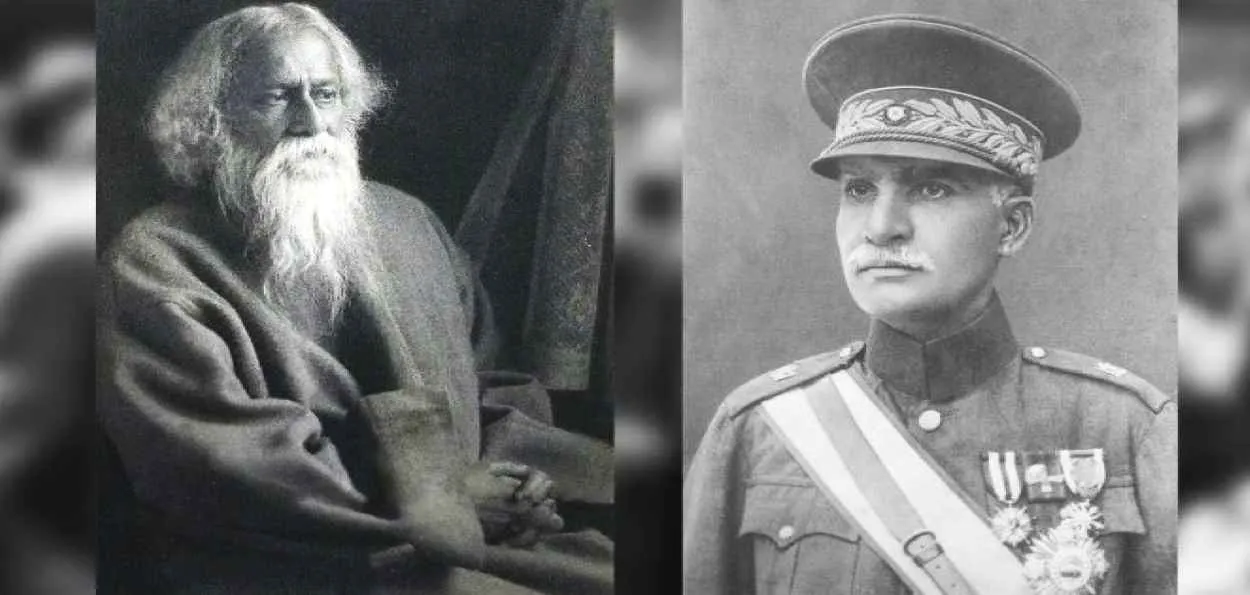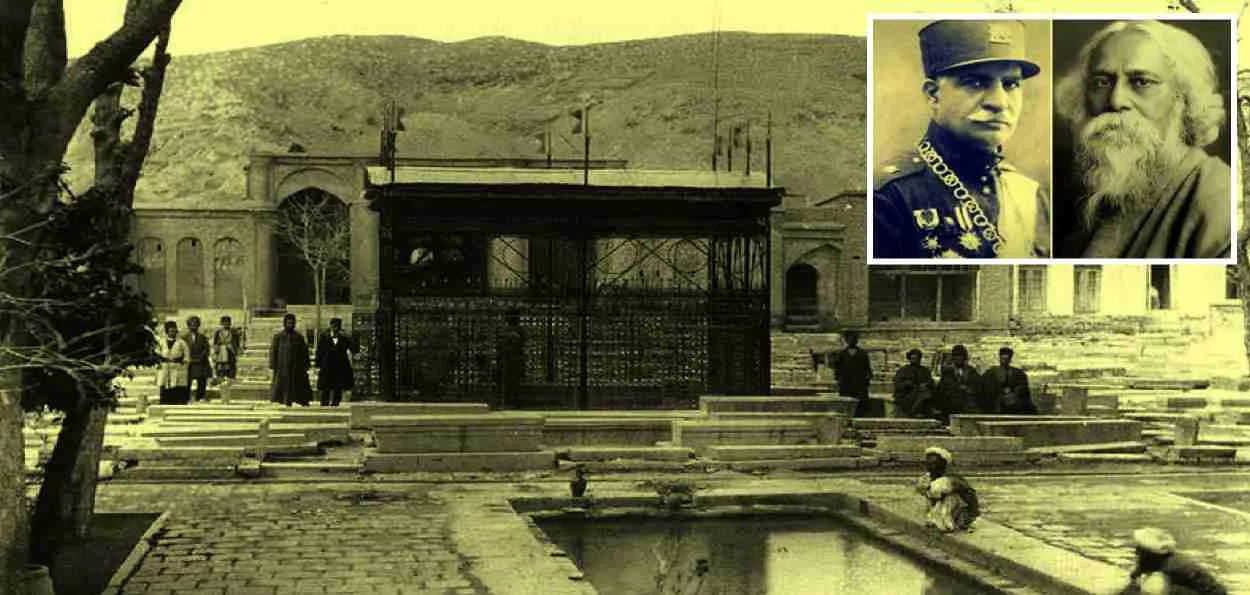.webp)
Mansooruddin Faridi/New Delhi
Rabindranath Tagore, India’s first Nobel laureate was a writer, philosopher, musician, and painter. His works not only had a great influence on India but also on the world. Much has been written about Tagore's relationship with the West but a lesser-known part of his life is his relationship with Iran, a country whose cultural ties with India go back more than 2,500 years. Both countries have age-old historical and civilizational relations. Zoroastrians, called Parsis in India, who fled persecution in 8th-century Persia and made India their permanent home are living proof of the ancient connections between the two countries.
Recently a seminar on Tagore and Iran was held in the Iran Society of Kolkata which was also attended by the representatives of the Iranian government. He spoke in detail about Rabindranath Tagore's visits to Shiraz and other cities of Iran in 1932 and 1934. He recalled Gurudev’s role in strengthening the Bengal-Iran literary bond. “Tagore's visit to Iran 90 years ago was an honour. It was the first step for Iranian scholars to get to know him. His works have been translated into Persian. We have a journal dedicated to Tagore's works,” he said.
Gurudev Rabindranath Tagore had a close relationship with Iran. Iranians not only read, understood, and appreciated Tagore but also invited the Nobel laureate to Iran. He was invited to the country and given a red carpet-welcome.
_xJi_xCz_cN7_epC_16r_(24).webp)
A scene from a seminar on Tagore and Iran held at the Kolkata Iran Society
Tagore was a guest of Shah Raza Shah Pahlavi; he visited the tombs of famous poets Saadi and Hafiz Shirazi and celebrated his birthday there. Tagore's literature gave him a following among Iranians and the remnants of it are still around.
Before winning the Nobel Prize for Literature in 1913, Rabindranath Tagore was not well known in Iran. Interestingly, till then only a select group of Iranian literati were aware of his work that was translated in languages such as French, German, and English. The Nobel Prize attracted Iran to Tagore and also because he happened to be one of the first people from the East to receive it. The Iranian elite quickly picked on him and he became popular.
Colonel Muhammad Taqi Khan Pisian, a great Iranian reformer and an officer, translated Tagore's poetry into Persian during his stay in Berlin between 1918 and 1920. In 1931, Iranian newspapers began publishing articles on Tagore. This widened the appeal of Gurudev’s works and raised his popularity in the country. His work was also publicized by his Iranian hosts who showed it as falling within the ambit of the ideological framework of Iran's Pahlavi nationalism.
Reza Shah Pahlavi became the emperor of Iran in 1925 by overthrowing the last crown prince, Ahmad Shah. At that time, Shah Pahlavi was determined to make Iran a major power in the world by giving it a modern identity. He also worked on restoring Iran's relations with other countries. One of them was India.
This was the time when the spirit of nationalism was emerging across the world. Nations were trying to find their origins and don a national identity. In this background, the idea of an Aryan identity was growing in popularity. For the Shah's political narrative, it was necessary to connect his country with the Aryan civilization. That way he wanted to reconnect Persia with the pre-Islamic Zoroastrian civilization. On the other hand, Tagore was a supporter of India's freedom movement.

Rabindernath Tagore and Raza Shah Pahlvi
So when Reza Shah Pahlavi invited Rabindranath Tagore to visit his country, he could not say no. Though Tagore was well aware of the Shah's wishes and designs yet he was curious about Iran and its royal family and accepted it. On April 11, 1932, Tagore, accompanied by Pratima Devi, his daughter-in-law, and his literary secretary Amiya Chakraborty, left for Iran by plane. Iran's hospitality and Shah Pahlavi's enthusiasm impressed and surprised him.
Tagore wrote the following lines about the Iranian king in his diary. “He had a great personality, his face was a picture of strength and the vastness of his heart was reflected in his eyes.”
Tagore celebrated his birthday (May 6) with the Iranians. The hosts appreciated his poetry; the government also gifted him a medal and an honorary book. The reception for Tagore was organized at the shrine of Sheikh Sadi, a famous Persian poet. The response was so overwhelming that the government had to deploy the army to control the crowds as a large number of people gathered at the venue.
Tagore wrote in his diary: “In my country… only my relations were there to be happy and make me happy. The recognition you have given me abroad today on the occasion of my birthday has made me truly a universal man.”
_xJi_xCz_cN7_epC_16r_(21).jpg)
Pictures clicked during Tagore's first visit to Iran
Tagore then visited the Iranian cities of Isfahan, Tehran and before meeting King Faisal of Iraq in Baghdad. He also visited the city of Kermanshah.
During a visit to the Sufi poet Hafiz's tomb in Shiraz, Tagore noticed that the ancient tomb was surrounded by a protective iron lattice. He sat near the tomb and read Hafiz's poetry. Interestingly, Hafiz visited Bengal in the 14th century at the invitation of Sultan Ghiyasuddin Azam Shah.
Tagore's momentous visit to Iran left a lasting impression on his soul, and it comes out vividly in his memoirs. “I had some knowledge of Persia before I came. I had read something about your history and geography and formed some ideas about your country and your people. So I dreamed of a Persia where nightingales loved roses. Where in the gardens of dreams poets sat around their wine-bowls and visions of unspeakable meaning. Now that I have come to your country, my dream has become a concrete image that has its permanence in the inner chamber of my experience.”
In 1934, Gurudev traveled again to Iran. This time, he took part in the Persian poet Firdausi's millennium celebrations. Tagore was 73 when he travelled and participated in the celebration of Firdausi's centenary and the inauguration of the great poet’s mausoleum. However, not much seems to be in the National Archives of Iran of his second visit. Tagore requested the Emperor of Iran to appoint a professor to teach Persian literature at Shantiniketan University. This request was gladly accepted by the Emperor and the Ministry of Education of Iran.
An Iranian scholar, Ibrahim Pourdaoud, was sent to India and he taught ancient Iranian literature at Shantiniketan. He also translated many of Tagore's poems from Bengali into Persian with the help of a local teacher, Ziauddin, and published these as a collection in Calcutta in 1935. Tagore organized a grand function at Shantiniketan to celebrate Nowruz in honour of Purdaoud. Tagore gave a handwritten letter to Pordaud on this occasion in which he praised Iranian culture, civilization, people, and their hospitality. He mentioned the spiritual relations between the two countries and the two civilizations.
When India celebrated the centenary of the poet, 20 years after his death, Mushfiq Kazmi, the Iranian ambassador to India, asked the Iranian authorities to provide all papers and articles about Tagore for the occasion. The centenary celebration took place on January 1, 1960 in Bombay. It was inaugurated by Prime Minister Jawaharlal Nehru and subsequently celebrated in Delhi in November 1961.
According to Iran Document No. 297-45689-217, Iran National Archives, the Chancellor of Tehran University, Dr. Farhad, presented a report to the Ministry of Culture on May 11, 1961, regarding the celebration of Tagore's centenary in which several proposals were made.
According to Iran National Archives document number 297-45689-51, the government of Iran agreed to the proposals that a high school and a road in Tehran should be named after 'Tagore'. Hence 'Shiraz street in the central part of the city, formerly known as 'Bahjatabad', was renamed after 'Tagore' in the winter of 1962. The third proposal of the Department of Higher Education and Cultural Relations was to hang Tagore's portrait and a tablet about his life in Jordan Hall of Albers High School which was visited by the poet during his visit.

A picture clicked during Tagore's visit to Iran
Besides, a booklet was to be compiled on Tagore's birth centenary celebrations. It also included a biography of him with several fragments of his works. Another proposal was to organize a celebration of Tagore's birth centenary in a high school in Tehran. According to Iran National Archives Document No. 297-45689-37, every program held during the centennial celebration was to begin with the reading of a message from the Shah of Iran and the Prime Minister.
In August 1960, the elections for the 20th National Parliament were held amidst allegations of massive rigging and it led to mass protests. According to Iran National Archives Document No. 297-45689-39, which ordered Mohammad Reza Shah to annul the elections, the uproar continued. The protest of Tehran University college students turned into a major political upheaval and it overshadowed every other issue, including Tagore's birth centenary celebrations.
Finally, after many months of delay, in January 1962 the name of 'Sherin High School' was officially changed to 'Tagore High School.'
Iran has gone through many changes and upheavals but its relations with India are the only constant. Despite domestic changes both India and Iran have maintained a balance in their relations. Iran saw the 1979 Khomeini revolution that overthrew the Pahlavi dynasty. Former Lok Sabha Speaker Meera Kumar visited Iran in 2011, she unveiled a Persian version of Rabindranath Tagore's poem Paroshe Janmudeen, which means Birthday in Persia.
It may be mentioned that Rabindranath Tagore went to England in 1878 to study law, but returned a year and a half without taking a degree and got busy reading and writing. During this time he wrote many fiction and paid attention to poetry.
ALSO READ: Ibn Sina Academy of Medieval Medicines and Sciences is a legacy in four walls
Tagore wrote mostly in Bengali. In 1901, at Bolpur, Bengal, he founded a new educational institution on Eastern and Western philosophies called Shanti Niketan, which became a university in 1921. At Shaniniketan, he translated his Bengali writings into English. He traveled to Europe, Japan, China, Russia, and America many times. In 1913, he received the Nobel Prize for Literature. In 1915, he was given the title of "Sir" by the British Government of India. However, he returned it as a mark of protest against the killings of common people in Punjab by the British troops
